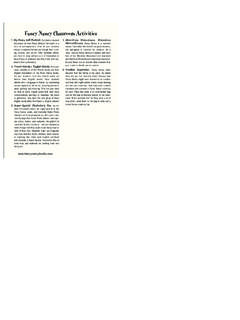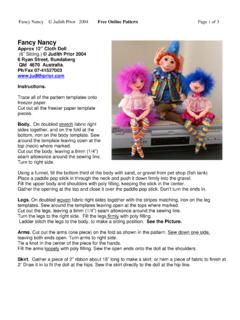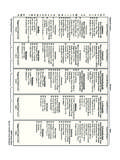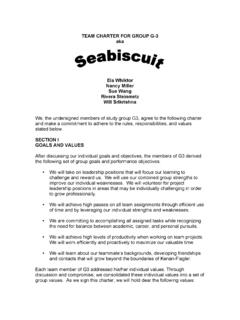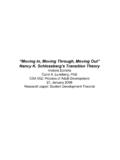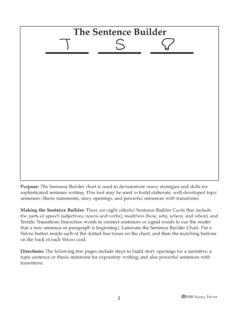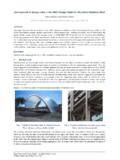Transcription of A study of whether, and how meetings held in a Thinking ...
1 A study of whether, and how meetings held in a Thinking Environment impact organisational lifeEmily HaversPr cis of a Masters Research thesis, 2008 ContentsAbout this publication 3 Introduction 5 The Results 11 Discussion 21 Conclusion 29 Notes 31 3 Running headAbout this publicationThis publication provides a pr cis of research I undertook in 2008 as part of an MSc in Coaching and Development with the University of Portsmouth. In producing this pr cis, prominence has been given to the results of primary research performed for the study and the subsequent discussion of these results in the context within which the study was performed.
2 The nature of a pr cis means that I have had to omit in this publication some aspects of the results and discussion that were included in the full manuscript. My intention however has been to maintain its spirit and balance appropriately. Please also note that The Thinking Environment is trademarked by Time to Think Ltd. This includes not only the Thinking Environment but also the Ten Components, Transforming meetings and Incisive Questions. By way of abbreviation, the trade mark symbol has not been referenced in this document where these terms are used.
3 My thanks go to all those who contributed to this research project. This includes the Interviewees, my Thinking Partners and study Buddies, all forty Thinking Environment Consultants worldwide, three very dear friends Sara, Jane and Elaine, and my family who listened, cajoled, proof-read and understood. If you would like to read the full manuscript, please contact me. Emily Havers+44 (0)7866 622 5 IntroductionThe Thinking Environment is a set of conditions that purport to help people to think well for themselves. It was developed by nancy Kline and her company Time to Think1 and is the product of the discovery that in order for people to think clearly and independently, the people around them need to behave in certain ways.
4 nancy depicts ten ways that she claims are fairly depend-able in this regard and these have become known as the Ten Components of a Thinking Environment. The need to think well for ourselves in various aspects of our work and lives encouraged Time to Think to develop several applications of the Thinking Environment. One of these applications, called Transforming meetings , creates a Thinking Environment in meetings . It works with a number of Principles and Behaviours to embody the Ten Components and so to generate people s best Thinking in a meeting environment.
5 If we consider the application of the Thinking Environment in meetings to be a system of human behaviours, values and assumptions, it could com-fortably be placed conceptually, into the field of organisation development interventions. As second generation organisation development takes a hold, the Thinking Environment complements the growing interest in organisational culture, the learning organisation and team working. It might sit alongside principles and practices such as Systems Thinking , Team discipline and coaching, Dialogue, World Cafe Conversations or the Six Thinking Hats.
6 That is not to say that any of these practices are similar, it is simply to say that they are all behavioural science principles and practices used in organisations to increase individual and organisational effectiveness. The emergence of principles and practices such as these might be seen to coincide with the disillusionment of the mechanistic, organisational concepts originating in the seventeenth century but still alive in the twentieth century. As organisations become increasingly aware of the need to unlock the unique potential within each individual worker to be successful in the new knowledge age, organisation development practitioners research, utilise, refine and teach methods that can achieve the release of human ingenuity.
7 As Margaret Wheatley alludes to though, ultimately this involves not only a change in practices but also a change in view ; a change in the way people think and a shift in the organisational assumptions underlying those practices. The Ten Components of a Thinking EnvironmentAttentioneAseequAlityAppreciA tionencourAgementFeelingsinFormAtionDive rsityincisive questionsplAceIn her leading text on leadership, Margaret Wheatley2 writes: There are many attempts to leave behind the view that predominated in the twentieth century when we believed that organisations could succeed by confining workers to narrow roles and asking only for very partial contributions.
8 As we let go of the machine model of organisations and workers as replaceable cogs in the machinery of production, we begin to see ourselves in much richer dimensions to appreciate our wholeness and hopefully to design organisations that honour and make use of the great gift of who we humans are. 6 7 IntroductionIntroductionof truth and reality or do these principles reach far beyond personal predilec-tions to the breadth of humanity? Combining this line of questioning with the context of the continued evolution of organisations in the twenty-first century led me to three specific research objectives, shown opposite.
9 The meeting environment was chosen for this study because of the centrality of meetings to an organisation s culture, performance and development. Although not the only entry point, meetings provide a major vehicle for people to do work together in organisations and they often explicitly set the ethical and performance standards for carrying out work. Implicitly, the culture of the meeting will most likely carry over beyond the meeting as well, generating multiple, often tacit outcomes from the meeting for the organisation.
10 The efficacy of a different approach to running meetings is also likely to be of interest to those executives and officers whose organisations form part of the evidence that suggests that meetings engulf time and money to little effect. American companies are said to hold over fifteen million meetings a day with senior and middle managers spending an estimated 60-80% of their time in meetings5. Whilst the loss of time in unproductive meetings has been estimated at $37billion annually for the USA6 the academic literature con-sistently draws conclusions of meeting ineffectiveness and dullness.
